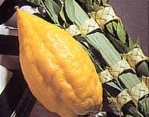 Why not stretch the value of your lulav and etrog this year with a little creative repurposing post-Yom Tov? When they can be shaken and blessed no more, try one or all of these suggestions for getting the most out of your four species.
Why not stretch the value of your lulav and etrog this year with a little creative repurposing post-Yom Tov? When they can be shaken and blessed no more, try one or all of these suggestions for getting the most out of your four species.
Lulav
The lulav bundle, including the palm fronds after which it is named, twigs of myrtle (hadasim), and willow branches (aravot), has customarily been put aside after the Sukkos and saved until Pesach. Having by then dried out, they are used to fuel the fire that burns the chametz found during the final cleaning of home, or as kindling in a wood-fire oven being used to bake matzah. Some also have the tradition of using the dried lulav palm as a broom to sweep up those last bits of hidden chametz. These are considered a respectful way to dispose of the lulav.
For something new this year, consider nourishing your creative side by exploring the art of palm weaving. The individual leaves of the lulav can be twisted and braided into variety of beautiful patterns, or folded into shapes like origami. Chabad.org recommends weaving palm leaves into a basket that can be used to hold spices for havdalah.
As for the hadasim, while still fresh they have a sweet and delicate fragrance, and can also be used for havdalah purposes. The oil of myrtle plants is known to have a variety of medicinal properties, although extracting it is not exactly a DIY project. Aravos, which tend dry and fall apart rather quickly, don’t lend themselves as well as hadasim to repurposing.
Esrog
The esrog (citron), the most aromatic of the Four Species and the only edible one, offers the most possibilities for efficient and enjoyable repurposing. One familiar strategy is to push whole cloves into the fresh esrog’s peel, filling up as much surface area as possible. The esrog will eventually dry out and shrivel up, but the cloves, now held in place in the shape of the fruit, retain their delectable scent and can be used for years to come as b’samim for havdalah.
Esrogim can also be boiled and turned into jelly, sliced and candied for a tangy dessert, or steeped in vodka for a citron liqueur. You can find a post on the blog Shivimpanim.org containing simple step-by-step instructions for each of these preparations.
By Binyamin Kagedan/JNS.org












Thanks for these great tips!
R Chaim Falagi cites the practice of using the aravah as a quill to write sifrei kodesh
also hung by one’s bedside as a segulah
This sounds like such an awesome idea
thanks for sharing